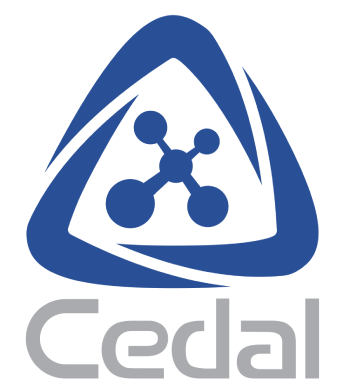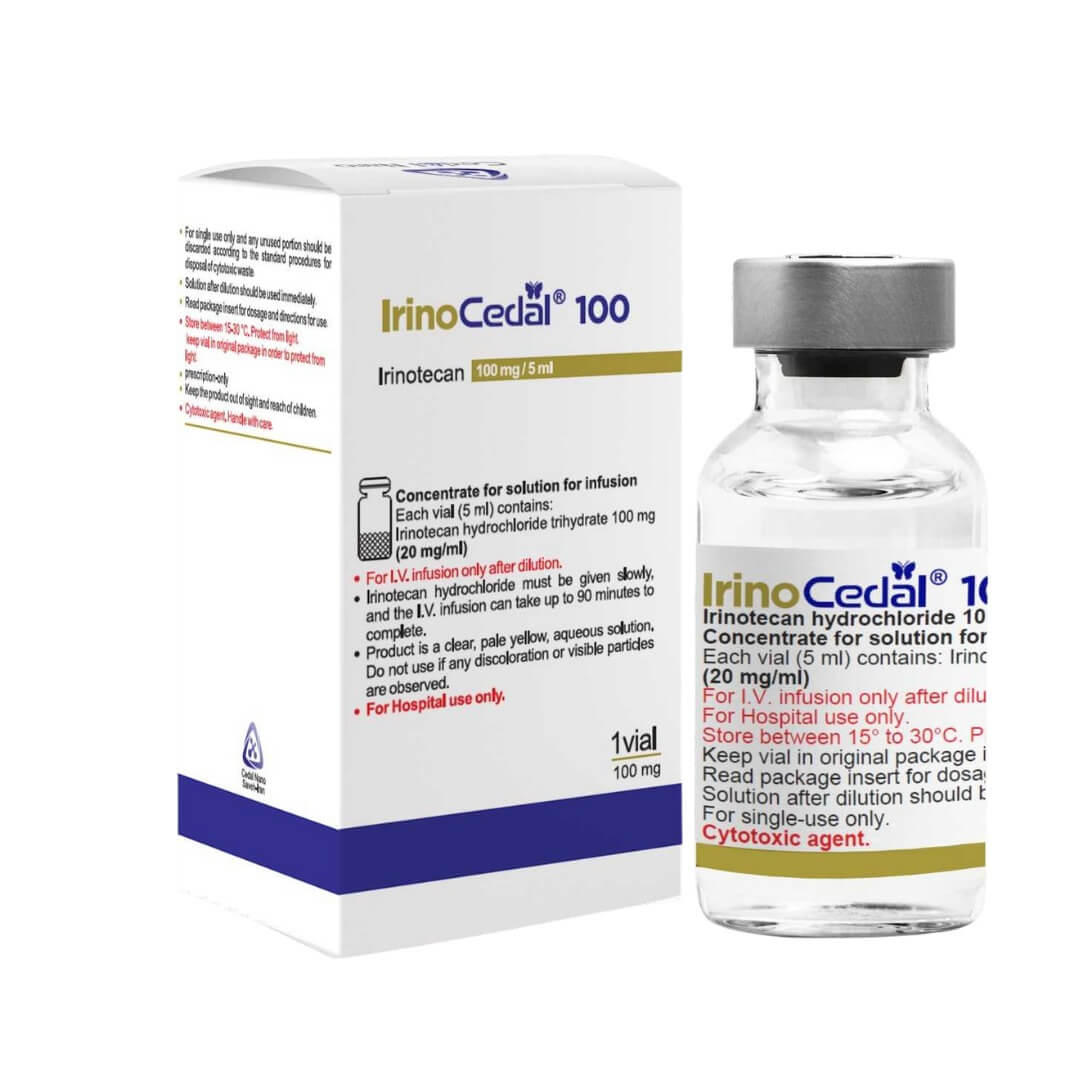– Colorectal Cancer Combination Regimens 1 and 2
Administer Irinocedal® as a 90-minute intravenous infusion followed by LV and 5-FU. The currently recommended regimens are shown in Table 1.
A reduction in the starting dose by one dose level of Irinocedal® may be considered for patients with any of the following conditions: prior pelvic/abdominal radiotherapy, performance status of 2, or increased bilirubin levels. Dosing for patients with bilirubin >2 mg/dL cannot be recommended because there is insufficient information to recommend a dose in these patients.
Table 1.Combination-Agent Dosage Regimens and Dose Modificationsa
Regimen 1 6-wk cycle with bolus 5-FU/LV (next cycle begins on day 43) | Irinocedal® LV 5-FU | 125 mg/m2 intravenous infusion over 90 minutes, days 1,8,15,22 20 mg/m2 intravenous injection bolus, days 1,8,15,22 500 mg/m2 intravenous injection bolus, days 1,8,15,22 |
Starting Dose & Modified Dose Levels (mg/m2) |
Starting Dose Dose Level -1 Dose Level -2 |
Irinocedal® LV 5-FU | 125 100 75 20 20 20 500 400 300 |
Regimen 2 6-wk cycle with infusional 5-FU/LV (next cycle begins on day 43) | Irinocedal® LV 5-FU Bolus 5-FU Infusionb | 180 mg/m2 intravenous infusion over 90 minutes, days 1,15,29 200 mg/m2 intravenous infusion over 2 hours, days 1,2,15,16,29,30 400 mg/m2 intravenous injection bolus, days 1,2,15,16,29,30 600 mg/m2 intravenous infusion over 22 hours, days 1,2,15,16,29,30 |
Starting Dose & Modified Dose Levels (mg/m2) |
Starting Dose Dose Level -1 Dose Level -2 |
Irinocedal® LV 5-FU Bolus 5-FU Infusionb | 180 150 120 200 200 200 400 320 240 600 480 360 |
a Dose reductions beyond Dose Level –2 by decrements of ≈ 20% may be warranted for patients continuing to experience toxicity. Provided intolerable toxicity does not develop, treatment with additional cycles may be continued indefinitely as long as patients continue to experience clinical benefit.
b Infusion follows bolus administration.
Dosing for patients with bilirubin >2 mg/dL cannot be recommended because there is insufficient information to recommend a dose in these patients.
Dose Modifications
Based on recommended dose levels described in Table 1, Combination Regimens of Irinocedal® and Dose Modifications, subsequent doses should be adjusted as suggested in Table 2, Recommended Dose Modifications for Combination Regimens. All dose modifications should be based on the worst preceding toxicity.
Table 2.Recommended Dose Modifications for
Irinocedal®/5-Fluorouracil (5-FU)/Leucovorin (LV) Combination Schedules
Patients should return to pre-treatment bowel function without requiring antidiarrhea medications for at least 24 hours before the next chemotherapy administration. A new cycle of therapy should not begin until the granulocyte count has recovered to 1500/mm3, and the platelet count has recovered to 100,000/mm3, and treatment-related diarrhea is fully resolved. Treatment should be delayed 1 to 2 weeks to allow for recovery from treatment-related toxicities. If the patient has not recovered after a 2-week delay, consideration should be given to discontinuing therapy.
Toxicity NCI CTC Grade a (Value) | During a Cycle of Therapy | At the Start of Subsequent Cycles of Therapy b |
No toxicity | Maintain dose level | Maintain dose level |
Neutropenia 1 (1500 to 1999/mm3) 2 (1000 to 1499/mm3) 3 (500 to 999/mm3) 4 (<500/mm3) | Maintain dose level 1 dose level Omit dose until resolved to grade 2, then 1 dose level Omit dose until resolved to grade 2, then 2 dose levels | Maintain dose level Maintain dose level 1 dose level 2 dose levels |
Neutropenic fever | Omit dose until resolved, then 2 dose levels |
Other hematologic toxicities | Dose modifications for leukopenia or thrombocytopenia during a cycle of therapy and at the start of subsequent cycles of therapy are also based on NCI toxicity criteria and are the same as recommended for neutropenia above. |
Diarrhea 1 (2-3 stools/day > pretx c) 2 (4-6 stools/day > pretx ) 3 (7-9 stools/day > pretx ) 4 (10 stools/day > pretx ) | Delay dose until resolved to baseline, then give same dose Omit dose until resolved to baseline, then 1 dose level Omit dose until resolved to baseline, then 1 dose level Omit dose until resolved to baseline, then 2 dose levels | Maintain dose level Maintain dose level 1 dose level 2 dose levels |
Other nonhematologic Toxicities d 1 2 3 4 | Maintain dose level Omit dose until resolved to grade 1, then 1 dose level Omit dose until resolved to grade 2, then 1 dose level Omit dose until resolved to grade 2, then 2 dose levels For mucositis/stomatitis decrease only 5-FU, not Irinocedal® | Maintain dose level Maintain dose level 1 dose level 2 dose levels For mucositis/stomatitis decrease only 5-FU, not Irinocedal® |
a National Cancer Institute Common Toxicity Criteria (version 1.0)
b Relative to the starting dose used in the previous cycle
c Pretreatment
d Excludes alopecia, anorexia, asthenia
– Colorectal Single Agent Regimens 1 and 2
Administer Irinocedal® as a 90-minute intravenous infusion. The currently recommended regimens are shown in Table 3. A reduction in the starting dose by one dose level of Irinocedal® may be considered for patients with any of the following conditions: prior pelvic/abdominal radiotherapy, performance status of 2, or increased bilirubin levels. Dosing for patients with bilirubin >2 mg/dL cannot be recommended because there is insufficient information to recommend a dose in these patients.
Table 3.Single-Agent Regimens of Irinocedal® and Dose Modifications
Regimen 1 (weekly) a | 125 mg/m2 intravenous infusion over 90 minutes, days 1,8,15,22 then 2-week rest |
Starting Dose and Modified Dose Levels c (mg/m2) |
Starting Dose Dose Level -1 Dose Level -2 |
125 100 75 |
Regimen 2 (every 3 weeks) b | 350 mg/m2 intravenous infusion over 90 minutes, once every 3 weeks c |
Starting Dose and Modified Dose Levels (mg/m2) |
Starting Dose Dose Level -1 Dose Level -2 |
350 300 250 |
a Subsequent doses may be adjusted as high as 150 mg/m2 or to as low as 50 mg/m2 in 25 to 50 mg/m2 decrements depending upon individual patient tolerance.
b Subsequent doses may be adjusted as low as 200 mg/m2 in 50 mg/m2 decrements depending upon individual patient tolerance.
c Provided intolerable toxicity does not develop, treatment with additional cycles may be continued indefinitely as long as patients continue to experience clinical benefit.
Dose Modifications
Based on recommended dose-levels described in Table 3, Single-Agent Regimens of Irinocedal® and Dose Modifications, subsequent doses should be adjusted as suggested in Table 4, Recommended Dose Modifications for Single-Agent Schedules. All dose modifications should be based on the worst preceding toxicity.
Table 4. Recommended Dose Modifications For Single-Agent Schedules a
A new cycle of therapy should not begin until the granulocyte count has recovered to 1500/mm3, and the platelet count has recovered to 100,000/mm3, and treatment-related diarrhea is fully resolved. Treatment should be delayed 1 to 2 weeks to allow for recovery from treatment-related toxicities. If the patient has not recovered after a 2-week delay, consideration should be given to discontinuing Irinocedal®.
Worst Toxicity NCI Grade b (Value) | During a Cycle of Therapy | At the Start of the Next Cycles of Therapy (After Adequate Recovery), Compared with the Starting Dose in the Previous Cycle a |
Weekly | Weekly | Once Every 3 Weeks |
No toxicity | Maintain dose level | 25 mg/m2 up to a maximum dose of 150 mg/m2 | Maintain dose level |
Neutropenia 1 (1500 to 1999/mm3) 2 (1000 to 1499/mm3) 3 (500 to 999/mm3) 4 (<500/mm3) | Maintain dose level 25 mg/m2 Omit dose until resolved to grade 2, then 25 mg/m2 Omit dose until resolved to grade 2, then 50 mg/m2 | Maintain dose level Maintain dose level 25 mg/m2 50 mg/m2 | Maintain dose level Maintain dose level 50 mg/m2 50 mg/m2 |
Neutropenic fever | Omit dose until resolved, then 50 mg/m2 when resolved | 50 mg/m2 | 50 mg/m2 |
Other hematologic toxicities | Dose modifications for leukopenia, thrombocytopenia, and anemia during a cycle of therapy and at the start of subsequent cycles of therapy are also based on NCI toxicity criteria and are the same as recommended for neutropenia above. |
Diarrhea 1 (2-3 stools/day > pretx c) 2 (4-6 stools/day > pretx ) 3 (7-9 stools/day > pretx ) 4 (10 stools/day > pretx ) | Maintain dose level 25 mg/m2 Omit dose until resolved to grade 2, then 25 mg/m2 Omit dose until resolved to grade 2 then 50 mg/m2 | Maintain dose level Maintain dose level 25 mg/m2 50 mg/m2 | Maintain dose level Maintain dose level 50 mg/m2 50 mg/m2 |
Other Nonhematologic d toxicities 1 2 3 4 | Maintain dose level 25 mg/m2 Omit dose until resolved to grade 2, then 25 mg/m2 Omit dose until resolved to grade 2, then 50 mg/m2 | Maintain dose level 25 mg/m2 25 mg/m2 50 mg/m2 | Maintain dose level 50 mg/m2 50 mg/m2 50 mg/m2 |
a All dose modifications should be based on the worst preceding toxicity
b National Cancer Institute Common Toxicity Criteria (version 1.0)
c Pretreatment
d Excludes alopecia, anorexia, asthenia
– Dosage in Patients with Reduced UGT1A1 Activity
When administered in combination with other agents, or as a single-agent, a reduction in the starting dose by at least one level of Irinocedal® should be considered for patients known to be homozygous for the UGT1A1*28 allele . However, the precise dose reduction in this patient populationis not known, and subsequent dose modifications should be considered based on individual patient tolerance to treatment (see Tables 1-4).
– Premedication
It is recommended that patients receive premedication with antiemetic agents. In studies of the weekly dosage schedule, the majority of patients received 10 mg of dexamethasone given in conjunction with another type of antiemetic agent, such as a 5-HT3 blocker (e.g., ondansetron or granisetron). Antiemetic agents should be given on the day of treatment, starting at least 30 minutes before administration of Irinocedal®. Physicians should also consider providing patients with an antiemetic regimen (e.g., prochlorperazine) for subsequent use as needed. A similar antiemetic regimen should be used with Irinocedal® in combination therapy.
Prophylactic or therapeutic administration of atropine should be considered in patient experiencing cholinergic symptoms.
– Irinocedal® is a sterile, pale yellow, clear, aqueous solution. Do not use if any discoloration or visible particles are observed.
– Irinocedal® Injection 20 mg/mL is intended for single use only and any unused portion should be discarded according to the standard procedures for disposal of cytotoxic waste.
– Irinocedal® Injection must be diluted prior to infusion. Irinocedal® should be diluted in 5% Dextrose Injection, USP, (preferred) or 0.9% Sodium Chloride Injection, USP, to a final concentration range of 0.12 mg/mL to 2.8 mg/mL.
– Other drugs should not be added to the infusion solution.
– Irinocedal® is injected into a vein through an intravenous route (IV). Irinocedal® must be given slowly, and the IV infusion can take up to 90 minutes to complete.
– Freezing Irinocedal® and admixtures of Irinocedal® may result in precipitation of the drug and should be avoided.
– Care should be taken to avoid extravasation, and the infusion site should be monitored for signs of inflammation. If extravasation occur, flushing the site with sterile water and applications of ice are recommended.


